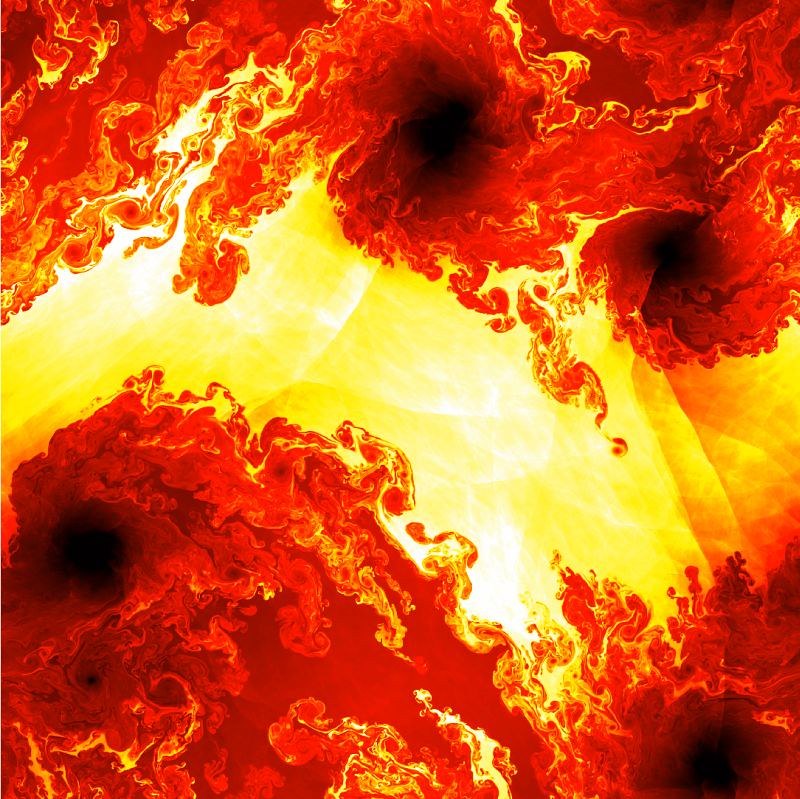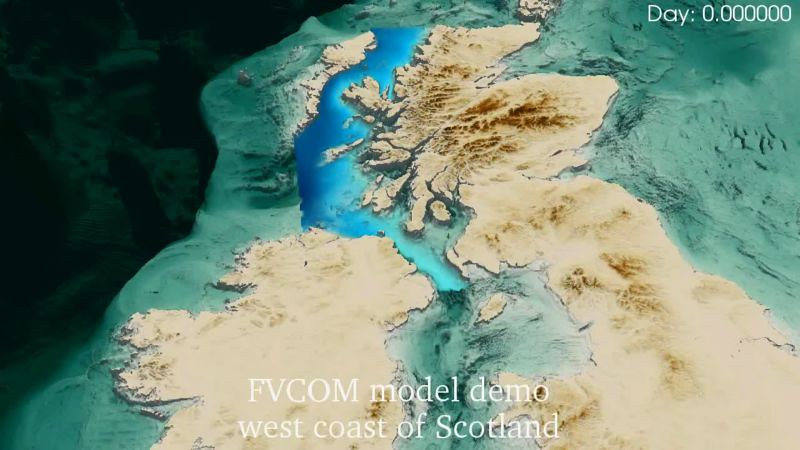
28. Formation of a Reverse Kármán Vortex Street in the Wake of a Morphing Wing
* * * 2025 Winning Image * * *
Miss Hibah Saddal, Chandan Bose, Department of Aerospace Engineering, University of Birmingham
A fully flexible aerofoil, with varying flexibilities at the leading and trailing edges, mitigates the effect of gust through passive morphing. The flexible morphing foil interacts with incoming fluid flow, creating a symmetrical reverse Kármán vortex street in its wake through the alternate shedding of opposite sense vortices resulting from the leading- and trailing-edge vortex interactions. Capturing this required high-fidelity simulations on the Archer2 HPC system by coupling OpenFOAM (finite-volume method) as the fluid solver with CalculiX (finite-element method) as the solid solver. This wake pattern, formed by a coherent train of vortices with opposite sense of rotation at high Strouhal number is representative of thrust generation. Visualised using finite-time Lyapunov exponent, this image showcases the benefits of dynamic fluid-structure interaction.

12. Ice is born in vibrating nanopores
* * * 2025 Winning Early Career entry * * *
Mr Pengxu Chen, School of Engineering, The University of Edinburgh
Ice nucleation in supercooled water begins when small molecular clusters organize into the first ice-like structures. The figure shows this process: white molecules indicate ice (transparent particles) forming within supercooled water (blue particles) confined in a nanopore whose wall vibrates. Molecular dynamics simulations reveal that vibration induces negative pressure as the wall stretches the confined liquid. This tension promotes the growth of larger ice-like clusters, thereby accelerating nucleation. Once these clusters reach a critical size, they coalesce into a stable front that propagates swiftly across the nanopore, transforming the entire volume into ice. All simulations were conducted in LAMMPS on the ARCHER2.
10. Electromagnetic waves propagation underground
* * * 2025 Winning Video and overall competition winning entry * * *
Dr Sebastien Lemaire, EPCC, University of Edinburgh
This video shows a gprMax simulation modelling the propagation of Electromagnetic fields coming from an above ground source into the earth. It models the interactions with the materials the fields come into contact with. The electric field (blue) is emitted at the surface, goes through the ground and interacts with a pair of perpendicular metallic pipes. These simulations enable the modelling of the return signature of subterranean structures, which have a variety of industry applications.
The simulation at the centre of the video uses an underlying grid of 750M cells and was run on 8 nodes using the UK national supercomputer ARCHER2. The data was then pre-processed using ParaView to export vdb files and perform a lossy data compression by discarding data points where the Electromagnetic field is negligible. Finally, the scene and all its components were designed and rendered using Blender.

18. Turbulent times
* * * 2024 Winning Image and overall competition winning entry * * *
Eric Breard, School of Geosciences, University of Edinburgh
The image shows a reproduction of the June 3rd, 2018 eruption at Fuego volcano, Guatemala. The volcanic plume reached around 15 km high, depositing ash to the north. The large-eddy simulation, which included the wind field, used the MFIX-classic Eulerian (solid-gas) solver and ran on ARCHER2's 1,200 CPU cores for 40 hours (simulating 2,000 seconds of real time). A North-South (XY plane) slice shows the log10 of particle concentration, highlighting entrainment's effect on plume dilution and buoyancy. Sediment waves produced ash fall on the nearby Acatenango volcano. The topography was modeled using a Lidar digital elevation model, resampled to a 20-meter resolution. This work is a collaboration between the Geophysical Flow Lab at the University of Edinburgh, Dr Jordan Musser (NETL, US DOE), and Pr Joe Dufek (University of Oregon), aiming to reproduce complex volcanic plumes under real atmospheric conditions, including 3D wind fields.
11. Effects of "wake steering" on wind turbine flows. The upwind turbine on the right is rotated to steer its wake away from the downstream turbine increasing the overall efficiency.
* * * 2024 Winning Video * * *
Dr Sébastien Lemaire, EPCC, University of Edinburgh
The video shows two computational fluid dynamics simulations of wind turbine flows ran using XCompact3D. On the left of the video, two turbines are placed are directly in line, while the second simulation, on the right, shows the angle of the front turbine "steered" by 24 degrees. The aim of "wake steering" is to redirect the wake from the turbine at the front and thus its impact on the turbine that sits downstream to increase the overall power output, in this case by 12%.
The video was generated using Blender in a photorealistic way to appeal to a broader audience. The normally invisible wakes are represented using Q-criterion, a method that highlights vortices from flows. It highlights the scale of off-shore wind turbines and their wakes, the slow evolution of the produced flow and the impact of "wake steering".
The simulations were performed by Andrew Mole (https://arxiv.org/abs/2407.20832).

7. Separated vortex ring above a three-dimensional porous disc
* * * 2024 Winning Early Career entry * * *
Dr Chandan Bose, Aerospace Engineering, School of Metallurgy and Materials, University of Birmingham
The primary motivation of studying the wake of a permeable disc stems from the idea of uncovering the role of porosity and permeability on the wind dispersal of biological seeds, such as dandelions. A stable separated vortex ring (SVR) forms in the wake of dandelion seeds, promoted by a filamentous pappus at the head of the seed, having porosity > 0.9. An SVR with a similar topology is also observed behind permeable disks with uniform permeability and porosity. Its existence is, however, limited within a specific range of the Reynolds number, and the Darcy number. The SVR is a stable toroidal vortex, whose closed streamlines are separated from the solid body. This flow feature is correlated with the high drag per projected area of the dandelion, that is an order of magnitude higher than that of an impervious disk with an equal area.
19. Silico model for assessing individual responses to irregular heart rhythm treatments.
* * * 2023 Winning Early Career entry * * *
Carlos Edgar Lopez Barrera, Queen Mary University of London, SEMS
This video demonstrates the creation of a personalized in silico model for assessing individual responses to irregular heart rhythm treatments. These customized computational models can predict how a patient will react to therapy and facilitate virtual trials. The process starts with a point cloud extracted from a segmented MRI scan, providing a spatial representation of the atrium. These points are interconnected to form a 3D finite element mesh that reflects the patient's unique anatomy. The cardiac tissue's directional properties, influenced by atrial fiber orientation, are incorporated from a DT-MRI atlas. The model then simulates electrical activity and electrograms using the openCARP solver to explore irregular heart rhythms like atrial fibrillation. Post-simulation analysis identifies critical atrial fibrillation regions. Procedures like radiofrequency catheter ablation or anti-arrhythmic drug administration can be virtually tested to predict the patient's individualized response, as demonstrated in this case with pulmonary vein isolation ablation therapy.
09. Mirroring a Pyroclastic Flow Experiment using Large-Eddy Simulation
* * * 2023 Winning Video * * *
Dr Eric Breard, School of Geoscience, University of Edinburgh
The image and video are derived from a Large-Eddy Simulation of a pyroclastic flow, consisting of a hot mixture of air and particles that travel down an inclined channel before spreading across a flat terrain. The simulation mirrors one large-scale experiment conducted in New Zealand and is part of an international initiative to validate numerical models in Volcanology. Turbulent eddies, sedimentation, and vertical density stratification are depicted using the flow's free surface (split in half along the centerline), a vertical slice showing solid concentration, and a solid boundary rendered as glass. The domain encompasses 60 million cells, covering a volume of 28*6*5 m3. The multiphase flow simulation addresses the mass, momentum, and energy equations for all six phases (air plus 5 solid phases) and captures the granular to dilute turbulent regimes. The simulation was run using the US DOE's MFIX solver, utilizing 1200 CPU cores on ARCHER2 for 15 days.

1. Modelling proton tunnelling in DNA replication
* * * 2023 Winning Image and overall competition winning entry * * *
Max Winokan, University of Surrey, Quantum Biology DTC
Proton transfer between the DNA bases can lead to mutagenic Adenine-Thymine tautomers. In our work, we determine that the energy required for generating tautomers radically changes during the separation of double-stranded DNA. Our results demonstrate that the unwinding of DNA by a helicase enzyme could significantly enhance the stability of tautomeric base pairs and provide a feasible pathway for DNA spontaneous mutations. This image shows the site of such a double proton transfer in a A-T base pair within the nucleic acid duplex. To produce the image atomic coordinates were taken from molecular dynamics simulations (Gromacs on Archer2) before being rendered in VMD. A Van der Waals envelope was added to show the atoms used in quantum chemical models. The image has been further altered in Photoshop to highlight the delocalised nature of the tunnelling proton. The quantum chemical calculations were performed with NWChem on Archer2.

15. Flow within and around a large wind farm
* * * 2022 Winning Early Career entry * * *
Dr Nikolaos Bempedelis, Imperial College London, Department of Aeronautics
Modern large-scale wind farms consist of multiple turbines clustered together in wind-rich sites. Turbine clustering suffers some drawbacks, as downstream turbines operate within the wake of upstream ones, resulting in the reduction of their power output due to wind speed deceleration and the increase of fatigue loads due to increased wind fluctuations. High-fidelity turbulence-resolving simulations allow us to study the dynamics of the interacting turbine wakes, providing insight into complex flow phenomena such as wake meandering, tip and hub vortex breakdown, and the interaction of the wind farm with the atmospheric boundary layer. The data was generated with the open-source flow solver Xcompact3D on ARCHER2.
12. One year in the southwestern Indian Ocean
* * * 2022 Winning Video * * *
Noam Vogt-Vincent, Department of Earth Sciences, University of Oxford
This video shows one year of sea-surface temperatures from WINDS-C, a 1/50° (c. 2km) resolution ocean model that covers almost all coral reefs in the southwestern Indian Ocean (SWIO). We have used this model (run on ARCHER2) to assess coral reef connectivity through larval dispersal on multi-decadal timescales across the SWIO. This video was made by rendering sea-surface temperature as a shaded height-map (as well as a traditional colourmap), which does a great job of emphasising flow across scales from 10s - 1000km. In this video, you can clearly see the major features of ocean circulation in the SWIO, such as the Southern Equatorial Current transporting water westwards towards Madagascar, which then intensifies into the rapid North Madagascar Current (flowing towards East Africa and shedding many eddies) and East Africa Coastal Current, which races northwards along the East African coast.
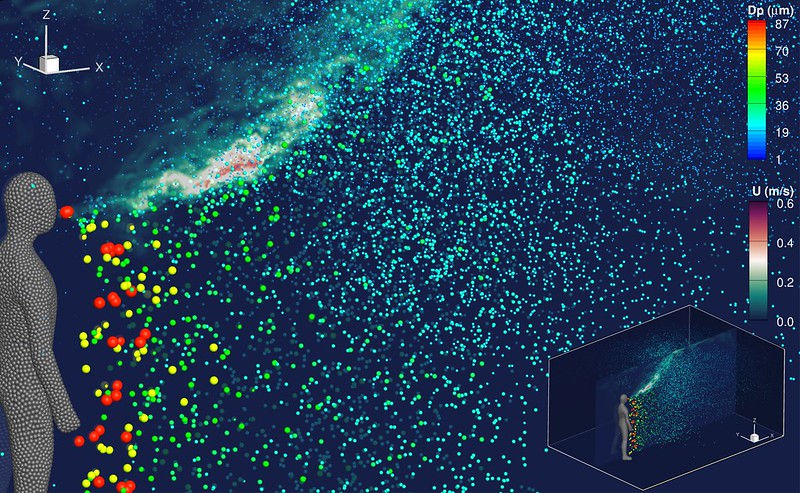
3. Expiratory particle dispersion by turbulent exhalation jet during speaking
* * * 2022 Winning Image and overall competition winning entry * * *
Aleksandra Monka, University of Birmingham, Department of Civil Engineering
The image reveals the extent of expiratory particle dispersion by the turbulent exhalation jet during speaking, with this high-resolution simulation run on the ARCHER2 system. A 3D overview figure of the whole room is shown in the bottom right-hand corner for spatial context. The particle’s ability to stay airborne is affected by its diameter: the largest particles (red and yellow) fall out close to the speaking person, while the smaller ones (blue) are entrained into the exhalation jet and transported throughout the room. The aim of the research is to develop a numerical tool to predict accurately the spread of airborne pathogens carried by very small expiratory particles in different indoor environments. The novelty of this work lies in the ability to determine and quantify the spatiotemporal distribution of airborne pathogens and the infection risk in different indoor scenarios, considering the turbulent mixing of particles on their spread.

5. Acoustic field (yellow and blue) with overlapped velocity isosurface (red) obtained with a coupled LES-High order Acoustic coupled solver of an installed jet case
* * * 2021 Winning Image * * *
Dr Miguel Moratilla-Vega, Loughborough University/Aeronautical and Automotive Engineering Department
The image reveals the interactions of jet turbulence and acoustic waves when the former is subject to a thin plate - a scenario often known as "installed" jets. High-frequency tones (yellow) as well as low-frequencies (blue) can be seen in the 3D rendering of the contour in the background. Jet turbulence is highlighted in red iso-surfaces in the foreground.
The aim of the research (partially supported by ARCHER eCSE12-20 project) is to develop a fast interface for a high-order acoustic solver, to couple with finite volume Navier-Stokes equations codes that are widely used in the UK Turbulence, Applied Aerodynamics and ARCHER communities. Using a high-order acoustic solver significantly widens the range of the sound spectrum captured further afield, hence is potentially a highly reliable approach that can be used not only for exploring flow/acoustics physics but as a predictive design tool for noise reduction.
3. Shock wave interaction with cavitation bubble.
* * * 2021 Winning Video * * *
Dr Panagiotis Tsoutsanis, Centre for Computational Engineering Sciences - Cranfield University
Interaction of a shock wave moving with Mach=2.4 and a gas-filled water bubble. These types of cavitation-bubbles can be found in several settings, ranging from our bloodstream to fuel droplets in hypersonic scramjet engines. Therefore, understanding the physical processes that occur during this interaction, can lead to more efficient targeted drug delivery, faster detection of neoplastic diseases through ultrasound imaging, and better protection from cavitation erosion and surface damage of hypersonic scramjet engines. The simulation was performed with the opensource freely available ucns3d software.

2. Sea surface temperature (colour) and ice concentration (grey shades) in the Greenland-Scotland Ridge region.
* * * 2021 Winning Early Career entry and overall winner * * *
Dr Mattia Almansi, Marine Systems Modelling - National Oceoanography Centre
The video shows the evolution of sea surface temperature and ice concentration in an ocean simulation covering the Greenland-Scotland Ridge. It is one of the regional 1/36°ree; simulations that are guiding the implementation of high-resolution zooms in a global 1/12°ree; model. The ultimate goal is to improve the overflows of deep water masses. The optimal final configuration is expected to improve the performance of the global model for climate timescales (decadal and multi-decadal). The simulation was designed and performed by the National Oceanography Centre as part of the IMMERSE project. The ocean general circulation model NEMO was run on the UK National Supercomputing Service Archer2.

14. Particles surf on plasma waves excited by high-power lasers
* * * 2020 Winning Image and overall winner * * *
Nitin Shukla, Instituto Superior Technico
Particle accelerators are fundamental tools for science and society, enabling scientific discoveries and providing unprecedented insights into fundamental propterties of nature. Miniaturization of those machines would open the way to several applications, from light sources to cancer treatments. Laser wakefield acceleration is a promising candidate to achieve what is called a table-top electron accelerator. The idea is to use a powerful laser to excite a wave in a plasma, an ionized gas and exploit the strong accelerating fields of the wave to accelerate electrons. The picture depicts a laser pulse (in color) causing a strong modulation in the plasma density (in blue) and thus driving the plasma wave. An electron beam (witness bunch, in orange) is injected ito the latter and gets accelerated. The simulation has been performed with the Particle-In-Cell code OSIRIS on ARCHER in the framework of the HPC-Europa3 program.

7. Endothelial glycocalyx -- defender of blood vessel walls
* * * 2020 Winning Early Career entry * * *
Xizhuo Jiang, University College London, Department of Mechanical Engineering
The lumen side of our blood vessel walls is covered by a tree-like structure called endothelial glycocalyx (EG). This image shows the EG conformation under blood flow conditions. In this research, a dissipative particle dynamics method is used to investigate the blood flow profile over the complex surface configuration with EG. All the simulations and post-processing are implemented on ARCHER.
The image is generated by VMD and trimmed in Adobe Illustrator.
6. Symmetric instability in a cross-equatorial western boundary current
* * * 2020 Winning Video * * *
Fraser Goldsworth, University of Oxford, AOPP
Intense currents form on the western boundaries of Oceans - the North Brazil Current is one such example. The video shows the potential vorticity (PV) in an idealised model of this cross-equatorial current. PV is a measure of how fast and in which direction a fluid is rotating.
Here we see anticyclonic (clockwise) eddies being spun up as the fluid crosses the equator. They have negative PV (shown in blue) and become symmetrically unstable. The instability generates small scale features within the eddies and sets their PV to zero (shown in white).
The simulation is from work investigating how symmetric instability effects the North Brazil current. ARCHER was used to run the model - without it, it would not have been possible to resolve the small scale instabilities which make this work so interesting!

28. Chiral molecules on a surface can be separated under the presence of an external oscillating field
* * * 2019 Winning Image entry * * *
Dr David Abbasi Perez, King's College London, Department of Physics
Chiral molecules are, like our hands, specular images and non superimposable. This is important for living beings, as one molecule can heal us, while its specular image may have devastating effects. They have identical chemical and physical properties, but different biological activity. This is why is important to separate them but is also a very difficult task. We propose a method that can control the diffusion of these molecules on a surface, once they are equally oriented, by applying an external field. The image represents two chiral molecules diffusing toward opposite directions under the influence of the field, represented by the blue and orange background. Many density functional theory calculations were carried out on Archer, and then we applied a kinetic Monte Carlo technique to simulate the movement of the molecules over long times. The image was created with the open source codes Jmol, Blender, Gimp and Krita.
27. Seismic Waves in the Ocean
* * * 2019 Winning Video and overall competition winning entry * * *
Mr Benjamin Fernando, Department of Earth Sciences, University of Oxford
Seismology - the study of earthquakes and the ground-shaking waves they produce - allows us to explore the interior of our planet, revealing details of its structure and behaviour which are otherwise hidden. One challenge, however, is understanding how the oceans affect the seismic waves which we observe and measure.
To investigate this effect, we build computer models of what we think the vibrations produced by a given earthquake should look like. This video shows such a prediction, from an earthquake in New Guinea. This is the first global-scale seismic simulation with a realistic ocean that we are aware of, and hence it represents an important step forward in seismic modelling.
We record the predicted wave energies on the seafloor, revealing a detailed and complex pattern which we can then compare to observations to learn more about the Earth's interior structure and the processes at work deep beneath the ground.

5. Turbulence-resolving simulations of a utility-scale offshore wind farm, highlighting the flow structures and turbulence of turbine wakes
* * * 2019 Winning Early Career Researcher entry * * *
Dr Georgios Deskos, Imperial College London
Coherent (vortical) structures of utility-scale offshore wind turbine wakes, interacting with each other and the ambient atmospheric turbulence.The present simulation was performed on ARCHER using the high-fidelity, high scalability wind farm simulator, WInc3D. The wind turbines are modelled using an enhanced actuator line model. Photos are not enhanced.
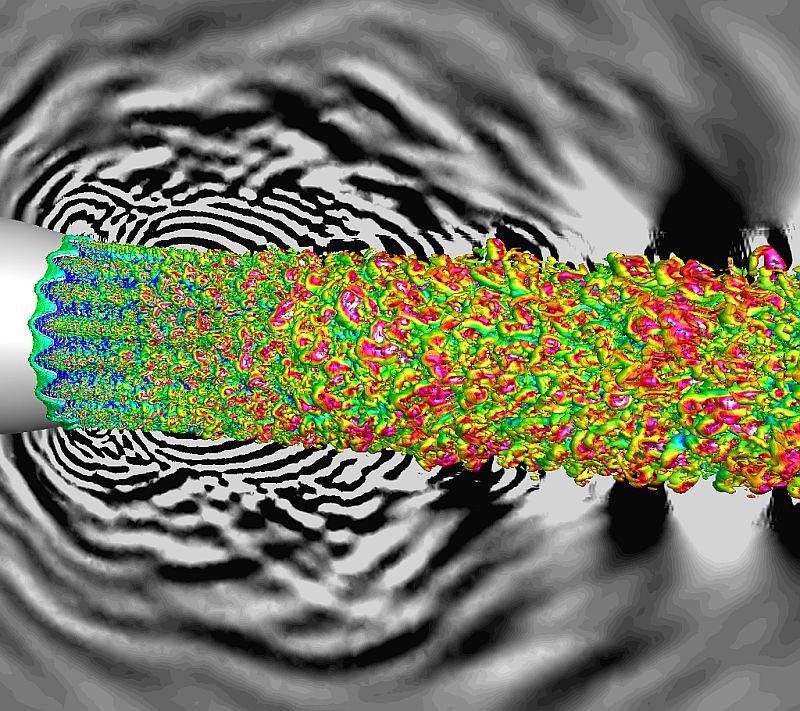
15. Turbulence-Generated Noise from a Serrated Nozzle Jet
* * * 2018 Winning Early Career Researcher and overall competition winning entry * * *
Zhong-Nan Wang, Department of Engineering, University of Cambridge
This image shows the broadband noise generated by a turbulent jet from serrated nozzle. The nozzle serration is used to break up turbulent structures into small scales for noise reduction. The q-criterion shows the turbulent structures and background grey-scale contours shows emitted acoustic waves. Multi-scale phenomena can be seen from perspectives of both turbulence and acoustics. Acoustic waves are generated at different locations in the near field and interfere as propagating to the far field.
13. Hypersaline sea surface release and propagation under tidal conditions in the northern North Sea
* * * 2018 Winning Video entry * * *
Pierre Cazenave, Plymouth Marine Laboratory, Marine Ecosystem Modelling and Prediction
A hypersaline point source is set up within an FVCOM model of a region in the northern North Sea. The very salty water is denser than its surroundings and so plummets to the sea bed in a single narrow column. Once at the bottom of the sea, the tides moves and mixes the salty water making it spread around the seabed, until it is mixed to the point it is indistinguishable from the rest of the water in the North Sea.
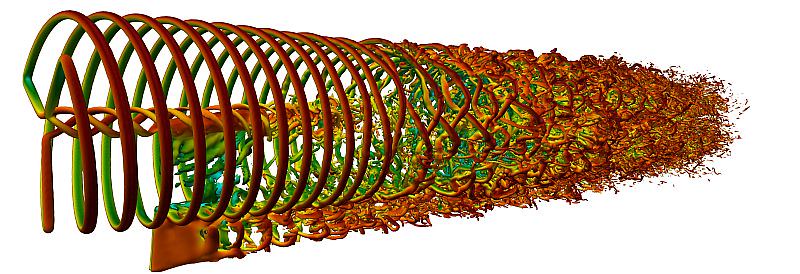
7. Turbulence-resolving simulation of the wake behind two in-line wind turbines
* * * 2018 Winning Image entry * * *
Georgios Deskos, Department of Aeronautics, Imperial College London
Vortical structures generated in the wake of two in-line wind turbines with an incoming velocity of 10 m/s. The simulation was performed on ARCHER using the high-order finite-difference flow framework Winc3d/Incompact3d. The wind turbines are modelled using an actuator line model. Photos are not enhanced.
17. Supersonic Kelvin-Helmholtz instability simulation
* * * 2017 Winning Early Career Researcher entry * * *
Panagiotis Tsoutsanis, Cranfield University, SATM
This is an animation of the simulation of the Kelvin-Helmholtz instability obtained with the CFD code UCNS3D on Archer. The animation shows the evolution of small shear layer instabilities into chaotic vortical structures, that interact with pressure waves.
Research for this type of problems are widely used by the scientific community as a tool to assess the suitability of various numerical methods and techniques for turbulent flows. This is of paramount importance firstly for improving our understanding of turbulence itself, and secondly to be able to more accurately and efficiently predict the behaviour of engineering and scientific designs under turbulent flow conditions.
12. West Scotland Coastal Ocean Modelling System (WeStCOMS) - 3D currents animation
* * * 2017 Winning Video and overall competition winning entry * * *
Dmitry Aleynik and Sam Jones, Scottish Association for Marine Science, Physics Department
Circulation pattern generated by the West Scotland Coastal Ocean Modelling System (WeStCOMS) run at ARCHER. WeStCOMS comprise an operational coupled ocean and atmospheric high-resolution three-dimensional hydrodynamic models based on the unstructured-mesh Finite Volume Community Ocean Model (FVCOM, 0.1÷3km) and the Weather Research Forecasts (WRF, 2x2km) respectively. Model results have been intensively validated against observations including current meters, conductivity/temperature/pressure sensors on stationary moorings, drifters, gliders. The visualization was created in cooperation with S. Jones over weekly hindcast runs. Operational model five-days forecasts enable stakeholders and community with the informed decision-making tool both in a field of academic research (stratified fluid tidal mixing, connectivity, sea-lice, pathogens, invasive species dispersal, Environmental Impact Assessment studies) and as an early warning predictive scheme for quick response mitigation measures during industrial and natural hazards, e.g. harmful algae bloom, oil spills, and in a support of sustainable development in Aquaculture, Renewable and other Blue Growth economy sectors.

4. Thermal plumes in thermally driven turbulence
* * * 2017 Winning Image entry * * *
Xiaojue Zhu, Physics of Fluids Group, University of Twente
This image shows the structures of three-dimensional turbulent thermal plumes in a box heated from below and cooled from the top, which is a simple model for the natural convection systems, such as those present in geo- and astro-physics. Turbulent thermal plumes are generated on the plates, forming the large scale rolls, mimicking the wind in Nature. This direct numerical simulation was performed on ARCHER with 1 billion grid points in a highly turbulent flow system.

9. The birth of a footprint
* * * 2016 COMPETITION WINNING ENTRY * * *
Dr Peter Falkingham, Natural Sciences & Psychology, Liverpool John Moores University
This image is of three stages of footprint formation, simulated by combining bi-planar X-ray data of a guineafowl walking over a sand-like substrate with a Discrete Element simulation of the substrate. X-ray Reconstruction of Moving Morphology (XROMM) was used to capture the motions of the leg and foot in a living animal. LIGGGHTS was then used to model the substrate, simulating grains of 1 mm diameter. Poppy seeds were used as the substrate as they behave like dry sand but are less dense, allowing X-rays to pass through.
This work has allowed us to link features of footprints - both at and below the surface - with motions of the foot, and is now being applied to understanding footprints made by long extinct dinosaurs.

29. Music, order and chaos in a combustion chamber
* * * 2015 COMPETITION WINNING ENTRY * * *
Mr Ivan Langella, University of Cambridge, Department of Engineering
This picture shows the flow inside a gas turbine combustion chamber computed using ARCHER. The swirling flow enters the chamber from the left as indicated by the arrows and evolves to become chaotic in the early part of the chamber, where vortical structures, colored by temperature, can be observed. A trumpet-like iso-pressure surface surrounded by this chaos is produced by the flow accelerating towards the exit because of the interaction between flame and turbulence. One can see order emerging from the chaos resulting in a beautiful flow structure. Understanding this interaction helps to construct "silent" combustors for future environmentally friendly gas turbine engines.
Colors represent temperature (red - high, blue - low) for vortical structures and velocity vectors, and vorticity on the iso-pressure surfaces.

27. Streamlines illustrating the temperature distribution and emergence of azimuthal currents within the flow of an irregular 3D liquid droplet undergoing phase change
* * * 2014 COMPETITION WINNING ENTRY * * *
Dr Pedro J. Sáenz, University of Edinburgh Institute for Materials and Processes
This image illustrates the flow and temperature distribution within an evaporating liquid droplet with elliptical contact area. For the first time, deformed drops have been simulated in three-dimensions, investigation which has elucidated the spontaneous emergence of previously-unknown azimuthal currents playing an essential role on the drop's flow and heat transfer mechanism. Understanding the dynamics of an evaporating droplet is a fundamental problem with a broad range of application, such as the development of new techniques for early diagnosis of several life-threatening diseases based on the pattern formation from drying drops of blood. The data depicted in the figure is the result of seven coupled nonlinear equations simultaneously solved at more than 8 million points, herculean task which would have required years to complete without ARCHER.










